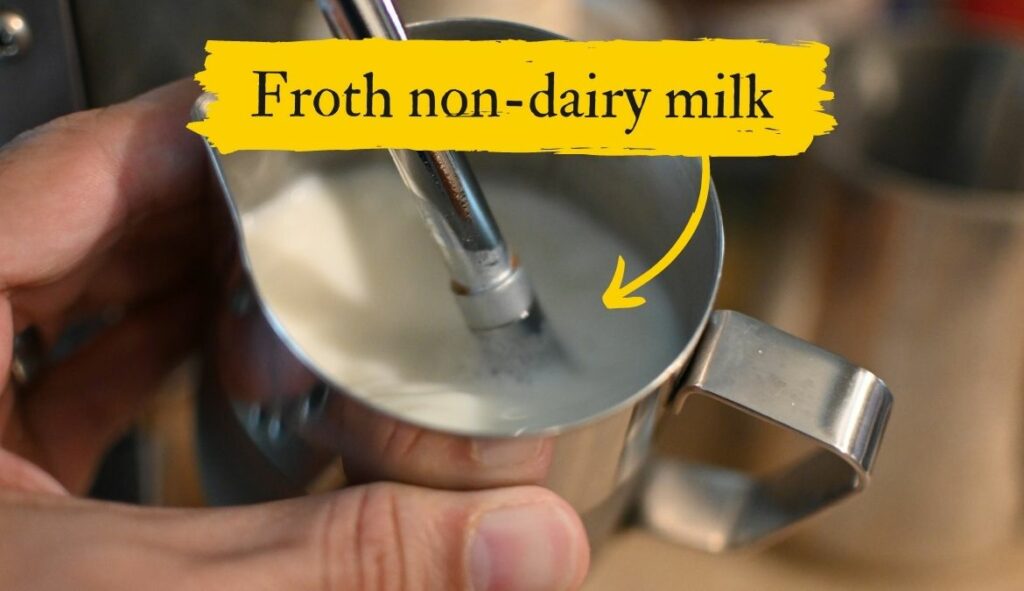While working as a barista, customers were often curious whether or not non-dairy milk could produce a comparable froth to regular dairy milk. Here’s what I learned.
Non-dairy milk with high protein and fat can be frothed very well. The protein and fat content in soy milk make it most comparable to dairy milk for frothing. Other non-dairy milks, such as almond milk and coconut milk, can produce froth as well. But the texture is a little different.
Although it can be difficult to perfectly imitate the satisfying texture of a rich whole-milk latte froth, many non-dairy milks can produce a nice head of foam. But the reason for this might surprise you.

Why dairy milk froths better than non-dairy milk
Many people think the lactose in dairy milk plays a major role in determining its foam quality. This is not the case. The truth is that milk foam has more to do with the protein and fat content in a particular brand of milk.
Dairy milk froths better than non-dairy milk because it typically has more protein, which is what surrounds foam bubbles and prevents them from popping. However, non-dairy milks often have a higher fat content which produces a finer and more silky foam.
How froth bubbles are formed
Froth is simply an amalgamation of air bubbles that sit atop a beverage, often a coffee-based drink. The froth bubbles can be formed using many methods including hand frothers, steam wands, whisks and blenders.
The consistency of a milk does play a role in determining the size the foam bubbles. But it’s the protein content of the milk that causes the bubbles to remain intact. These proteins wrap around the bubbles and protect them from popping.
As a result, non-dairy and dairy milks with high protein content are often the best for achieving a nice frothy beverage. Here are common nutrition fact among the most popular dairy and non-dairy milk varieties:
| Milk type (8 ounces) | Fat (grams) | Protein (grams) |
| Regular whole milk | 8 | 8 |
| Regular 1% milk | 2 | 8 |
| Regular skim milk | 0 | 8 |
| Soy milk | 4 | 7 |
| Oat milk | 2 | 4 |
| Almond milk | 3 | 2 |
| Coconut milk | 5 | 0 |
| Rice milk | 2 | 0 |
As you can see from the table above, dairy milk typically has a higher protein content per volume than most non-dairy milks. This is the main reason these types of milks produce a more consistent froth.
What’s Interesting is that whole milk and skim milk have almost the same protein content. However, if you’ve ever seen the froth from each of these milk types you’ll know that the consistency isn’t quite the same.
So, what’s going on here?
It turns out that fat content also plays a role in determining the consistency of the froth bubbles. Generally speaking, a higher fat content will cause the bubbles to be smaller, which will give it a smoother and almost velvety texture. Whereas skim milk, with a lower fat content, will produce froth with larger bubbles.
They both are able to sustain a good volume of froth due to the high protein content. But the varying fat content changes the texture and mouthfeel of the final product.
With this information in mind, you can start to understand which non-dairy milks might be best suited for producing a nice froth.
Best non dairy milk to froth
Soy milk typically produces the largest froth volume with the most satisfying texture, among the main non-dairy milk alternatives. This is because it has a comparable protein content per volume to dairy milk and a reasonable amount of fat as well.
Oat milk would be your second best option if you want to maximize the volume of froth you get. It has a protein content of 4g per 8 ounces, with 2g of fat.
Almond milk is somewhere in the middle. A common unsweetened almond milk brand will have somewhere in the range of 2-4g of protein per 8 ounces, which is lower than the 7g of protein in many soy milks and 8g in dairy milks. It does have a comparable amount of fat, which means the bubble size and texture will be similar.
Rice and coconut milk are the most difficult to froth because they usually have very minimal or zero protein content, which is the main nutrient that retains foam bubbles. You will likely notice foam forming while you are frothing these milks, but it will quickly dissipate after the frothing stops.
Can you froth unsweetened milk?
Unsweetened milk can absolutely be frothed. The sugar content in milk does not largely contribute to its ability to produce foam – the protein and fat will. And unsweetened milks usually have the same or similar amount of protein and fat, which makes them no less suitable for frothing. Therefore, both sweetened and unsweetened milk can be used to prepare a delicious frothy beverage.
Can you froth powdered creamer?
Powdered creamer typically won’t produce a froth with as much volume or texture as a dairy milk because it has a very low protein content. However, you can certainly achieve some froth by using the same process as you would with any other kind of milk.
How to froth non-dairy milk with hand frother
The process for hand frothing non-dairy milk, such as almond milk, soy milk or coconut milk, is really quite easy. Follow these steps:
- Heat your non-dairy milk until it’s very warm but not boiling. You can do this by using a microwave safe mug for 30 seconds. Or you can simply heat it up in a small saucepan.
- Pour your warm non-dairy milk into your hand frother container (or French Press) and slowly press the plunger down until you can fasten the lid to the top of the container. Make sure your container is no more than half full as the froth will add volume.
- While holding the lid in place, plunge up and down for 20-30 seconds until you achieve a froth consistency that you desire.
- Remove the lid and use a spoon to hold back the foam as you pour the liquid into your mug. Then pour or spoon the foam on top.
How to froth non-dairy milk in a saucepan with a whisk
This method is certainly the most labor-intensive, but it might be your only option if you don’t have a hand frother, French Press or blender available.
- Heat your non-dairy milk in a saucepan until it’s very warm but not boiling.
- Whisk the warmed milk in a circular motion until you achieve your desired froth consistency. The more air you’re able to whisk into the milk, the more froth you will produce. This can be a little tricky if you’re preparing a single-serving because your milk won’t be deep enough to effectively use your whisk. Consider using a smaller saucepan so you have a deeper amount of milk to work with.
- Use a spoon to hold back the foam and pour the liquid out of your saucepan into your mug. Then slowly pour or spoon the foam on top. Be careful not to introduce too much turbulence or the foam might start dissipating.
How to froth non-dairy milk with a blender
The blender method is probably the least labor-intensive method for frothing non-dairy milk, other than using a steam wand. All you have to do is warm your milk up in the microwave for 30 seconds or heat in a saucepan, and then blend until you achieve your desired forth consistency.
I have found that the blender blades seem to produce a much finer froth consistency, but a smaller foam volume than a hand frother or French Press. But you will still be able to achieve a good result.

